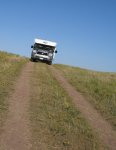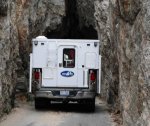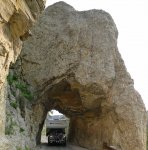As early car campers who worked our way up a good size travel trailer over the years, we decided it was time to downsize and return to our roots. We started off backpacking and car camping, but with the arrival of kids, quickly moved into tent trailers, then a “pop out” and finally a 22 foot Nash hard side travel trailer. We had our Nash for 7 years and loved the creature comforts. But, increasing storage fees, the difficulty of picking it up from storage to escape town, low gas mileage, and having to forego some of our favorite camping spots because of its size, we gave it up. The final straw was last September on a month long trip to Grand Staircase Escalante National Monument (GSENM), and the surrounding National Parks. There we had to camp too far away from some of the major trail heads and destinations, especially in GSENM and Canyon Lands. Out there we also saw some of the pop up truck campers at remote locations and that peaked our interest in truck camping for the first time. Before that we considered truck campers as too cumbersome, hard to drive and requiring too big of a truck. Pop ups seemed different and we liked what we were seeing – smaller trucks with small popups out in the middle of nowhere!
So when we got back from our trip, we started doing out research. It didn’t take long to decide that we definitely wanted to go the pop up truck camper route to down size. See our “thread” at http://www.expeditionportal.com/for...n-Denver?highlight=phoenix+hallmark+outfitter to read about our decision to buy a custom made Phoenix Pop up from Rob and Cari in Denver CO. Only having a Toyota Tundra with a long bed, we knew we wanted to stay small and light. We placed our order in April.
A long six weeks passed and June finally arrived. A date was set with Cari to pick up our new toy. We left Washington DC about 5pm Tuesday evening and drove as hard as we could to Denver, arriving about 36 hours later at my sister-in-law’s on Wednesday evening. We tried to maintain 75 mph on the way out and keep a pretty good record of gas so we could compare gas millage later between an empty truck, truck with a travel trailer, and our new truck camper. I’ll discuss our gas mileage in a later post.
On Thursday morning we met Rob and Cari at Phoenix. They were fantastic and patient showing us our new toy, especially considering that they had a car crash on the way to work that morning. They showed us how to use everything, and ran through a good inspection of all the features. Loading the camper was straight forward with Rob’s help. The back of my Tundra dropped about 3 1/2 inches on our truck with no suspension modifications. Topped off the tire pressure and we were off.
We left about 2 pm and headed the truck scales for the fully loaded weight. We weighted in at 8000 lbs and subtracting the morning weight (all gear and people were included in it too) and accounting for the propane and water that was in the cassette toilet and fresh water tank, the dry weight without any gear should be very near 1460 lbs which was right in the middle of Rob’s estimated weight. I’m convinced one of the dirty secrets of truck camping is campers are out there routinely exceeding their GVWR. Several of the standard RV dealers we visited to check out their “off the shelf” campers were pushing us towards campers with a dry weight of 1600 – 1800 lbs. I never felt that would work on Tundra. After the weigh in, we were off for a quick over nighter to double check everything and let the family see our new toy. On Friday we headed north to Devils Tower in Wyoming for a day, then 4 days in the Black Hills of South Dakota followed by 3 days in the Badlands before the sprint home to DC.
Heading north on I-25 we could see the smoke from the High Park Fire. The truck and the camper handled well together. Cornering did not seem to be an issue on the interstate, at high speeds or in the winding paved and dirt roads of the Black Hills. Acceleration and breaking seemed fine. I could barely tell there was a camper in the back until we discovered porpoising. Several times at greater than 70 mph, crossing an uneven bridge, or when entering the buffeting slip stream from a semi truck, the camper would develop a strong fore and aft pitching and shaking. Slowing down always made it dissipate immediately. Still, this was something new and we wanted to be sure nothing was wrong. A quick email and response from Rob said it would not cause any structural problems and happens in truck campers sometimes. So we decided to keep pushing, and just slow down when it happened. He also had several suggestions that he did talk about earlier back at the shop and reiterated in his response. His first choice is the cab to camper pad (an inflatable “inner tube”) to provide support and shock absorption, and a 3M Clear Bra to prevent scratching your paint on the roof of your cab. I’ll come back to this topic with a solution I thinks works better in a later post.
Here is how we tricked out our custom TC from Phoenix:
-Wet bath with cassette toilet
-Large Dometic fridge and freezer
-On demand hot water (works great)
-Cramer 3 burner stove and sink combo
-2 solar panels for charging a large AGM battery
-30 gal fresh water tank
-LED lights throughout and great LED backlights for late night arrivals
-Heki II skylight for over the bed
-Yakima tracks to support a future roof rack
-2 rear Thule bike racks
-Ladder to the roof
-N/S bed and camper short enough to fit inside the tailgate of the truck

Why we like Truck Campers - Going anywhere and remote camping. Fantasic Night Sky that night!
Dirt trail in Buffalo National Grassland just outside of Badlands National Park

Tight Fit. Try that with a large travel trailer.

Camping with the Buffalos at Sage Creek Badlands
So when we got back from our trip, we started doing out research. It didn’t take long to decide that we definitely wanted to go the pop up truck camper route to down size. See our “thread” at http://www.expeditionportal.com/for...n-Denver?highlight=phoenix+hallmark+outfitter to read about our decision to buy a custom made Phoenix Pop up from Rob and Cari in Denver CO. Only having a Toyota Tundra with a long bed, we knew we wanted to stay small and light. We placed our order in April.
A long six weeks passed and June finally arrived. A date was set with Cari to pick up our new toy. We left Washington DC about 5pm Tuesday evening and drove as hard as we could to Denver, arriving about 36 hours later at my sister-in-law’s on Wednesday evening. We tried to maintain 75 mph on the way out and keep a pretty good record of gas so we could compare gas millage later between an empty truck, truck with a travel trailer, and our new truck camper. I’ll discuss our gas mileage in a later post.
On Thursday morning we met Rob and Cari at Phoenix. They were fantastic and patient showing us our new toy, especially considering that they had a car crash on the way to work that morning. They showed us how to use everything, and ran through a good inspection of all the features. Loading the camper was straight forward with Rob’s help. The back of my Tundra dropped about 3 1/2 inches on our truck with no suspension modifications. Topped off the tire pressure and we were off.
We left about 2 pm and headed the truck scales for the fully loaded weight. We weighted in at 8000 lbs and subtracting the morning weight (all gear and people were included in it too) and accounting for the propane and water that was in the cassette toilet and fresh water tank, the dry weight without any gear should be very near 1460 lbs which was right in the middle of Rob’s estimated weight. I’m convinced one of the dirty secrets of truck camping is campers are out there routinely exceeding their GVWR. Several of the standard RV dealers we visited to check out their “off the shelf” campers were pushing us towards campers with a dry weight of 1600 – 1800 lbs. I never felt that would work on Tundra. After the weigh in, we were off for a quick over nighter to double check everything and let the family see our new toy. On Friday we headed north to Devils Tower in Wyoming for a day, then 4 days in the Black Hills of South Dakota followed by 3 days in the Badlands before the sprint home to DC.
Heading north on I-25 we could see the smoke from the High Park Fire. The truck and the camper handled well together. Cornering did not seem to be an issue on the interstate, at high speeds or in the winding paved and dirt roads of the Black Hills. Acceleration and breaking seemed fine. I could barely tell there was a camper in the back until we discovered porpoising. Several times at greater than 70 mph, crossing an uneven bridge, or when entering the buffeting slip stream from a semi truck, the camper would develop a strong fore and aft pitching and shaking. Slowing down always made it dissipate immediately. Still, this was something new and we wanted to be sure nothing was wrong. A quick email and response from Rob said it would not cause any structural problems and happens in truck campers sometimes. So we decided to keep pushing, and just slow down when it happened. He also had several suggestions that he did talk about earlier back at the shop and reiterated in his response. His first choice is the cab to camper pad (an inflatable “inner tube”) to provide support and shock absorption, and a 3M Clear Bra to prevent scratching your paint on the roof of your cab. I’ll come back to this topic with a solution I thinks works better in a later post.
Here is how we tricked out our custom TC from Phoenix:
-Wet bath with cassette toilet
-Large Dometic fridge and freezer
-On demand hot water (works great)
-Cramer 3 burner stove and sink combo
-2 solar panels for charging a large AGM battery
-30 gal fresh water tank
-LED lights throughout and great LED backlights for late night arrivals
-Heki II skylight for over the bed
-Yakima tracks to support a future roof rack
-2 rear Thule bike racks
-Ladder to the roof
-N/S bed and camper short enough to fit inside the tailgate of the truck

Why we like Truck Campers - Going anywhere and remote camping. Fantasic Night Sky that night!
Dirt trail in Buffalo National Grassland just outside of Badlands National Park

Tight Fit. Try that with a large travel trailer.

Camping with the Buffalos at Sage Creek Badlands

